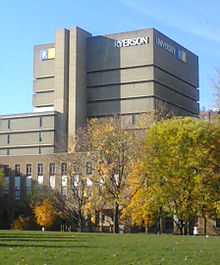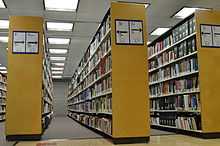Ryerson University Library
| Ryerson University Library | |
|---|---|
 | |
| Looking at the Ryerson University Library from inside the Quad | |
| Country | Canada |
| Type | Academic library |
| Established | 1974 |
| Location | Toronto, Ontario |
| Collection | |
| Items collected | Books, journals, newspapers, sound recordings, databases, maps, drawings |
| Size | 500,000 books, 3,700 journal titles |
| Website | ryerson.ca/library |

Ryerson University Library is the library of Ryerson University in Toronto, Canada. The Ryerson Library collection consists of over 500,000 books, 3,700 print journal titles and over $2 million of electronic resources, including approximately 23,000 e-journals, e-books, databases and indexes, geospatial data, and catalogued websites or electronic documents. Most of the electronic resources can be accessed remotely by Ryerson community members with Internet access, although authentication of Ryerson Library registration is required for access to all commercial resources. The Library acquires materials to support the curriculum taught at the university and to support the research needs of faculty. All hard copy materials are housed in the Library building at Gould and Victoria Streets.
The 11 storey tower was built in 1974, and is a classic example of Brutalist architecture. The library buildings also holds administrative office, the Nursing Collaborative and until 2007 the Urban and Regional Planning program. Urban and Regional Planning vacated the building in 2007, leaving more space for the existing library.
As part of the Ryerson University Master Plan, the Library is expected to either relocate or be the subject of extensive renovations in the next several years.
On January 18, 2008 the university announced the acquisition of properties including the former site of Sam the Record Man which will allow expansion of the library to a prime Yonge Street location. The new expansion will be designed by architectural firms Zeidler Partnership Architects of Toronto and Snøhetta of Oslo, Norway.
Ronald D. Besse Information & Learning Commons
The Ronald D. Besse Information and Learning Commons, located on the main floor of the Ryerson University Library, provides access to a wide range of information resources with advanced technology and provides the expertise necessary to allow student, faculty and staff to successfully integrate information with technology in their academic pursuits.
Established with a generous donation by Ronald D. Besse, the Commons provides learning support through a variety of services such as peer tutoring, classroom instruction, reference services and technology support.
Microcomputer facilities
The Ryerson Library has over 180 microcomputers available for use by members of the Ryerson community. The majority of these computers are on the main floor of the Library in the Information and Learning Commons area; the rest are located on floors 5 through 10. Many of these machines now require users to authenticate themselves via a login procedure.
The Microcomputer facilities on the 3rd floor are administered by Computing and Communications Services, not by the Library. The lounge area, and the teaching lab LIB393b (when it is not booked for classroom use) are available on a drop in basis to all members of the Ryerson community and to those with External Borrower or Alumni Cards.
Geospatial data
The Ryerson University Library has access to a range of geospatial data via agreements with various federal, provincial and municipal agencies as well as with private corporations and companies. These data include air photos, topographic data & remotely sensed images among others.
Ryerson Archives
The University Archives is a repository and research facility within the Library that documents the history of the University and forerunner institutions located at St. James Square, which has been called the cradle of education in Ontario for its significance in the development of the educational system in the province. The Archives was established in 1971 on recommendation of the Smyth Commission on Ryerson Polytechnic University's governance and organization. The Archives mandate is to acquire, appraise, maintain and provide access to those records which have enduring value to the University for administrative, legal, fiscal, and historical purposes. In 1982, Records Management was added to the Archives mandate in order to provide guidance to University departments. The Archives is the final repository for University records of enduring value, and serves as the institutional memory of Ryerson University and its antecedent institutions.
Special collections
The Ryerson Library has recently acquired two significant collections which will greatly enhance its support of Image Arts programs, particularly the Masters Program in Photographic Preservation and Collections Management . Kodak Canada has recently donated its entire historic company archives to Ryerson University. The Library will also soon acquire an extensive collection of materials on the history of photography from the private collection of Nicholas M. and Marilyn A. Graver of Rochester, New York.
The Kodak Archives, which begin in 1909, contain historic photos, files, trade circulars, Kodak magazines, price lists, daily record books, cameras, equipment and other ephemera. The cameras and equipment are being housed in the School of Image Arts, and the print and photograph collection is currently being processed in the Library with assistance from graduate students in Photographic Preservation and Collections Management. The processing of this collection is expected to be an ongoing project, and will provide a valuable hands-on learning opportunity for students in this program.
The Graver collection, built up over many years, consists of over 1,000 books, periodicals, catalogues, and other similar material related to the history of photography. The Library is indeed fortunate to have acquired this extensive collection, which adds breadth and depth to its current holdings. Given the steps involved in incorporating these new materials into the collection, they may not be immediately available to users.
The Library thanks Kodak Canada for their generous donation, and Nicholas and Marilyn Graver for their role in helping to improve the Library's collection in the history of photography.
The Writing Centre
This free, drop-in facility is for all Ryerson University students, undergraduate or graduate, who want help with their writing and is located inside the library and is part of the Learning Commons. Appointments may be booked with peer-tutors for help with specific assignments and general writing skills. The Writing Centre has also prepared a series of handouts for use by Ryerson community members.
Changes to library space
- Relocation of staff - the 1st floor of the Library building, which was previously occupied by the Faculty of Social Work, became vacant and was allocated to the Library. A number of staff in the Collections Team, and some librarians have been relocated to work out of this space.
- New study spaces – as a result of the relocation of staff, the 5th floor was redesigned to allow for increased study space, with additional group study rooms and a planned study room with 26 individual carrels. Offices previously occupied by librarians on the 7th floor are now available as group study rooms. The Library obtained the 4th floor when the School of Urban and Regional Planning relocated. This floor was renovated into an open work area for students with special rooms set aside for grad students.
Mission statement
The Library is the primary academic information resource for the University. It promotes learning, supports teaching, and enhances scholarly, research and creative activities. It does so by building collections and providing expert and innovative services and access to information.
Values The Library is committed to:
- Providing responsive and professional service to its users
- Being respectful and inclusive
- Ensuring intellectual freedom and the privacy of its users
- Providing an environment that stimulates learning, teaching, research and study
- Meeting the teaching and research needs of its users
- Ensuring the most effective use of available resources
- Exploring creative methods of enhancing services and resources
- Working collaboratively
References
| Wikimedia Commons has media related to Ryerson University Library. |
- Guide to the Ryerson Library
- Nexus - The Library Newsletter
- Library Update
- Official site
- Ryerson Library Building
- Writing Centre Website
Coordinates: 43°39′28″N 79°22′51″W / 43.65779°N 79.380716°W